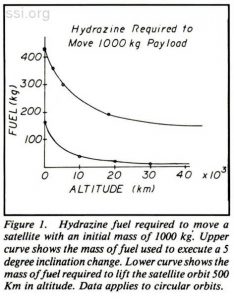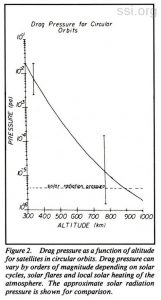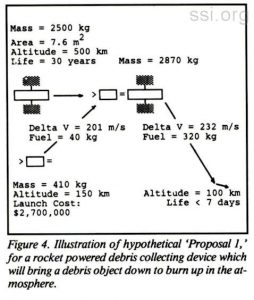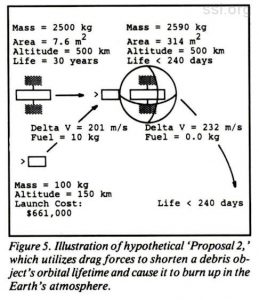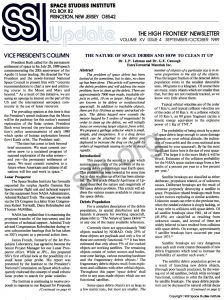
SPACE STUDIES INSTITUTE
P.O. BOX 82
PRINCETON, NEW JERSEY 08542
[[librarian note: This address is here, as it was in the original printed newsletter, for historical reasons. It is no longer the physical address of SSI. For contributions, please see this page]]
SSI UPDATE
THE HIGH FRONTIER® NEWSLETTER
VOLUME XV ISSUE 4
SEPTEMBER/OCTOBER 1989
VICE PRESIDENT’S COLUMN
President Bush called for the permanent settlement of space in his July 20, 1989 speech commemorating the 20th anniversary of the Apollo 11 lunar landing. He directed the Vice President and the newly-formed National Space Council to present him with “concrete recommendations to chart a new and continuing course to the Moon and Mars and beyond.” As a result of this initiative, we are seeing an upsurge in interest on the part of the US and the international aerospace community in the use of lunar resources.
The prevailing opinion at this time is that the President’s speech indicates that the Moon will be the pathway for this nation’s manned exploration of the Solar system. President Bush went beyond the previous administration’s policy announcement of early 1988 which spoke of human exploration beyond (low) Earth orbit. The President said:
“The time has come to look beyond brief encounters. We must commit ourselves anew to a sustained program of manned exploration of the solar system and yes – the permanent settlement of space. We must commit ourselves to a future where Americans and citizens of all nations will live and work in space.”
Lunar Prospector
The Space Studies Institute has formally requested the surplus Apollo Gamma Ray Spectrometer flight unit and technical support for this equipment from NASA Administrator, Admiral Richard Truly. The request was made via the US Congress in a letter from Congressmen Robert Torricelli, Dana Rohrabacher and Thomas McMillan.
NASA has replied that it is examining the proposed transfer of the instrument and the provision of technical support. Admiral Truly advised Congressman Rohrabacher during recent subcommitee hearings that he has taken on SSI’s request as a personal action item.
James French, formerly of the Jet Propulsion Laboratory, has agreed to become the Senior Project Manager for our Lunar Prospector effort. While at JPL, Jim prepared SSI’s first official look at the possibility of a small lunar polar probe. His report was presented by the Institute to the President’s National Commission on Space which subsequently endorsed the concept of small robotic lunar probes to search for polar volatiles.
The Institute is continuing to receive proposals in response to our Request for Proposals for the design study to develop the Lunar Prospector Spacecraft. Many thanks to each of you who are supporting this work. In particular, thanks to the Chicago Society for Space Studies, which just as we went to press, sent its contribution of one thousand dollars fo assist in the design project.
Gregg Maryniak
THE NATURE OF SPACE DEBRIS AND HOW TO CLEAN IT UP
Dr. L.P. Lehman and Dr. G.E. Canough
ExtraTerrestrial Materials Inc.
Abstract
The problem of space debris has been looked at for sometime, but to date, no clean up has been done. This article will summarize the debris problem and will address the main problem; how to clean up the debris. There are approximately 7000 man made, trackable objects in orbit, JO cm or larger. Most ofthese are known to be debris or nonfunctional spacecraft. In addition to trackable objects, there are 8 to JO times as many untracked objects. The debris hazard now exceeds the meteor hazard by 5 orders of magnitude! In order to clean up the debris, we will initially focus on removing larger objects from orbit. We propose a garbage collector which is small, simple, and inexpensive. It is a drag device which can be attached to the debris and deployed to increase the drag on the junk by orders ofmagnitude causing its orbit to decay rapidly.
Introduction
This paper is the second in a pair which summarizes a study of the problem of the increasing debris population in near Earth space. This problem has been looked at for some time but to date no clean up effort has been attempted. The first article (March/ April issue of Update) described the nature and magnitude of the space debris problem. This article will address the various means available to clean up the space debris.
Debris Population
For a complete description of the debris population, its spatial distribution and the hazards it presents for working spacecraft, please refer to “The Nature ofSpace Debris”[16] or any one of the many available references.
Currently there are approximately 7000 objects tracked by NORAD. Only 250/o of these objects are payloads and only a few of these are currently functional.[12, 13] It has been estimated that only about 5% of the tracked objects are working satellites. The remaining objects consist of rocket motors and bodies, nose cone fairings, various mounting hardware and the fragmentary debris objects.[3] The fragmentary debris objects result from explosions and collisions with other orbital objects. Throughout this paper ‘space debris’ shall ref er to any man made objects which are not functional satellites.
Some space debris objects are as large as a few metric tons, but most are smaller. The number ofobjects ofa particular size is in inverse proportion to the size of the objects. Thus the largest fraction of the detected debris population exists in the smallest detectable sizes, 100 grams to a kilogram. Of course there are many, many objects which are smaller than that, but they are not routinely tracked, so we know very little about them.
Typical orbital velocities are of the order of 7 Km/s, and typical collision velocities are of the order of 10 Km/s. At a collision velocity of 10 Km/s, an 80 gram fragment carries. a kinetic energy equivalent to the explosive power of 1 Kg of TNT.[14]
The probability of being struck by a piece of space debris large enough to cause damage depends on your orbital altitude, the inclination of your orbit and the cross sectional area presented by your spacecraft. By far the most significant factor here is the size of your spacecraft. The larger it is the more likely it will be struck. Estimates of the collision probability for the NASA space station range from a few tenths of a percent per year to a few percent per year.[3]
Satellite breakups are classified as either deliberate, propulsion related, or of unknown causes. Deliberate breakups are the result of someone purposely destroying a satellite in space. Propulsion related breakups result from rocket motors exploding or similar accidents. Unknown causes can refer to the previous two, when the needed evidence is simply lacking, or it may refer to collisions with space debris. Of all satellite breakups since 1961, 44 of them (45.8%) are classified as resulting from unknown causes, and several of these are widely believed to have resulted from collisions with space debris. On average, approximately 5 satellite breakups have occurred per year since 1975.[12]
Satellite breakups are very dangerous since each such event creates thousands of new debris fragments which tend to increase the probability of another such event.[5]
The satellite debris population grows as a result of launching new debris objects, (through poor launch practices), by the wearing out of old satellites, (which while no longer functional, continue to orbit the Earth), and by satellite breakups. The space debris population can be decreased by natural orbital decay processes or by actual debris collection. There have been no attempts to collect any space debris to date. As of April, 1989, the satellite population was growing at a rate of approximately 240 per year.[12]
Nearly all small debris objects are created as fragments of large satellites. While no practical scheme has been devised to clean up the large population of small space debris objects, it is believed that by removing the large nonfunctional satellites the source of the small debris objects will be removed.[5] This is the concept on which the present debris collection plans will be based.
Near Earth Space
Near Earth space is not just empty space, it is a complete environment with the equivalent of landscape, resources and even weather. In order to understand how to deal with space debris in near Earth space, we must first try to understand the environment of near Earth space.
The Idealized Gravity Well
The single most significant and most obvious factor in navigating near Earth space is the gravity well. Figure 1 shows the mass or fuel required to change the orbital path of a 1000 Kg payload. Notice that the fuel demands for a 500 Km altitude change drops off rapidly with altitude, while the fuel demands for a 5 degree inclination change are much greater and drop off more slowly. This means that any craft dependent on rocket fuel for propulsion will have a fairly narrow range of inclinations it can reach. Figure 1 also implies that, for a given fuel supply, a spacecraft will be able to reach a greater range of altitudes starting at a high altitude than if it starts at a low altitude.
Satellites do not follow ideal orbital paths around the Earth. They are constantly being perturbed by a number of small forces. There are forces due to the oblateness of the Earth, the effects of solar and lunar gravity, the radiation from the sun and from drag caused by the tenuous atmosphere at lower altitudes.[21]
The effects of oblateness of the Earth and solar and lunar gravity are generally conservative with respect to the orbital energy of a satellite. They tend to change a satellite’s apogee, perigee and inclination over time but do not significantly change its orbital energy.
Drag is inherently energy dissipating and solar radiation can either increase or decrease a satellite’s energy depending on the satellite’s properties, orientation and orbital position. Drag forces always tend to act anti-parallel to a satellite’s instantaneous velocity vector and with greater force at lower altitudes. Solar radiation pressure acts radially outward from the sun and is nearly constant throughout near Earth space.
Since both drag and solar radiation pressure depend directly on the cross sectional area of the satellite presented to them, both can be exploited by controlling a spacecraft’s shape and/or orientation. The magnitude of the effects can be see in Figure 2.
Collection or Removal of Orbital Debris
Natural Decay of Orbits
The easiest means of removing orbital space debris is to simply allow it to decay naturally from orbit. This will happen eventually for all objects in near Earth orbit due to the perturbing forces mentioned earlier, but in many cases the rates of decay could be rather disappointing. Objects orbiting above 500 Km altitude generally have orbital lifetimes measured in tens of years, depending on their cross sectional area. Objects orbiting above 1,000 Km altitude, have lifetimes measured in thousands of years. Taking into account launches and other sources of new debris, objects decayed from orbit and objects boosted to interplanetary space, the total debris population is still found to grow at a rate of about 240 objects per year.[12] Thus, simply waiting does not seem to be a reasonable means of reducing the population of space debris.
Debris Recycling
One popular plan to remove space debris is to collect the debris in orbit and process it into useful materials for further space development.
This will require a central processing depot on orbit to store and process debris materials for later use. It will require fuel to
maintain it’s orbit, since like everything else in orbit it will experience perturbations. Ifactual processing of materials is to be accomplished, it will require receiving docks and shipping docks and automatic processing machinery and probably a great deal of power.
In order to collect the debris and bring it to the depot a semi-autonomous robot will be required. The robot will require arms for grappling with the debris and possibly a solar furnace to cut the debris into manageable chunks and rocket engines to make trips to and from the depot.
This is a plan of some merit and ideally something like this may someday be done. At present most of the automatic, and semiautomatic technologies are not very mature. The engineering time scale required to make this a reality will be at least ten years, given a dedicated effort. This plan also has an unfavorable operating cost based on fuel requirements for operation over a range of altitudes and orbital inclinations. Currently every kilogram on orbit has a $3,000 launch cost, at minimum. (Let us hope for a significant reduction in launch costs.)
Exploitation of Natural Forces
Debris can be collected or removed from orbit without decades of development or tons of fuel by breaking the problem down into smaller categories.
Near Earth space is made up of smaller regions which have distinct environmental differences. Low altitude, below approximately 700 Km, is dominated by drag, the principal perturbing force. Above that is a regime dominated by solar radiation pressure. The Earth’s magnetic field permeates most of near Earth space and can produce perturbations on properly constructed spacecraft. The Van Allen radiation belts often represent a haz.ard for spacecraft, forcing mission designers to be conscious of its presence.[20]
In the same way, not all space debris is created equal.[3] Debris objects come in all sizes and shapes. Plans to collect a large object may not be practical for a small object and vise versa. By targeting plans for specific classes of objects in specific regions of space, designers can create simple specialized spacecraft for these well defined missions.
In order to minimize cost, fuel expenditures must be kept to a minimum (fuel costs $3,000 per pound in orbit). Fuel cost can be minimized by exploiting the natural forces present in space.
Drag Forces
In low altitude regimes where drag is the dominate perturbing force, objects can be dragged down to burn up in the atmosphere, see Figure 3.[11,17] A spacecraft can be designed to move from LEO to rendezvous with the debris object by rocket power. Then the craft will attach a large drag device to the debris object and allow the natural forces to bring the object down, at a highly accelerated rate.
Solar Radiation Pressure
In the regime dominated by solar radiation pressure, altitudes generally greater than 1,000 Km, it is possible to use solar radiation to maneuver a spacecraft. By creating a solar sail space tug, it may be possible to capture debris objects through a wide range of altitudes and inclinations.
At altitudes well above the atmospheric drag regime it may be more advantageous to collect the debris at an orbital depot rather than remove it from orbit. The advantage will be gained from use of solar sailing debris collectors which may operate for many years of continuous service, with little or no fuel required.
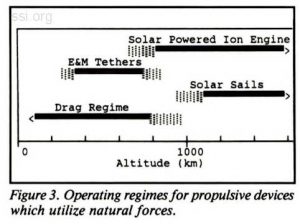
These will be very slow and massive devices,[18] with a maximum payload which is less than half of the total mass of the sail alone. Also automatic pilots for these craft will be very complex since they will operate in a condition of continuous and varying acceleration. The sail surface must be continuously reoriented throughout each orbital period, taking into account the position of the Earth, Sun, Moon and its own instantaneous velocity vector.
Solar Energy Powered Ion Engines
The use of solar energy to power ion engines for propulsion represents another form of exploitation of natural forces. Ion engines can be constructed to use solar energy either as direct heat or by converting it to electrical energy. Both techniques require very large energy collection surfaces and thus suffer excessive drag inside the drag regime. Outside the drag regime ion engines have a performance roughly comparable to that of the solar sails. With lSP’S (specific impulses) often in excess of 4000/s, fuel mass is minimal. However, the fuel supplies must still be periodically replenished.
These craft will be very slow and, like the solar sail, require very complex control systems to operate under continuously varying accelerations. The region of applicability is the same as that of the solar sail for many of the same reasons.
Earth Magnetism and Gravity Gradient
The Earth’s magnetic field and the strong gravity gradient present in near Earth space offer a synergistic combination for electromagnetic tether vehicles. These craft can operate effectively between the altitudes of 150 Km and 500 Km in a generally equatorial orbit.[10] This is roughly the same as the drag regime because the electromagnetic tether requires a substantial plasma density to complete its electrical circuit. The necessary electrical energy might be obtained from solar cells or from a nuclear source. Maneuvering can be accomplished through electromagnetic propulsion against the Earth’s magnetic field. This is done by forcing a current though the vertical tether as it cuts through the horizontal magnetic field lines. The plasma in space completes the electric circuit by providing a second conducting path from one end of the tether to the other.
These craft might be used to tether large masses of debris and exploit that mass to give orbital transfers boosts to other satellites. In the simplest scenario possible, debris collection might be implemented by overtaking the debris at a small relative velocity and capturing it in a net like device.
Tethers are very complex dynamic systems requiring precise mechanical controls to keep the system from swinging, twisting or vibrating too much.[9]
Due to the large surface to volume ratio of tethers, they have a high probability of impact with small debris particles resulting in a very short service life for tethers of any practical length. Multiple tether systems can extend the service life but at a cost of considerable additional mechanical complexity.[9]
Stabilization of rotational vibrational modes of the tether system may require the use of rocket thrusters, especially during rendezvous and capture of space debris objects.
The Small Dumb Debris Collector
Highly complex systems which use unproven technologies typically require twenty years to reach a stage of practical application. These will probably require government backing to support the very long payback periods. Both the ion engine powered collector and the solar sail tug may be examples of this. The lectromagnetic tether may simply not be workable as a debris collector due to its short service life.
However, the drag device stands out as a candidate for private development. Objects with a small area to mass ratio tend to have longer lifetimes in the drag regime. Thus by attaching a very light, large area drag device to the objects, the area/mass ratio can be increased by orders of magnitude. The objects expected orbital lifetime will then be decreased in much the same proportion. The area/mass ratio of the combined drag device and debris object should be approximately 0.12m2/Kg to achieve lifetimes less than 240 days for altitudes less than 500 Km.
Typically one drag device will be required for each individual debris object. Each drag device will be rather simple, light and compact during the launch phase. It can be launched to LEO and then rendezvous by the use of rocket thrusters, and compressed gas thrusters. The target debris object can be captured by use of a net like device. It could deploy a drag surface in the form of a balloon like surface, expanded and rigidified. After deployment the craft is basically inert, and requires no further actions to accomplish its task. The only moderately difficult task here is to rendezvous with and capture the debris object.
Many of these devices can be made and used, all identical, varying only the siu in proportion to the target debris object. Thus certain economies of scale can be realized with respect to the development cost.
Hypothetical Case
Suppose a derelict satellite orbits at 500 Km altitude in roughly circular orbit. Its mass is 2500 Kg and its cross section for drag is only about 6.7m2 The estimated lifetime for such a satellite is about 30 years, i.e. the time till the natural decay of its orbit causes it to burn up in the atmosphere. Also suppose that this satellite is determined to be a hazard to navigation and plans are made to remove it from orbit. A request for proposals is issued.
Proposal 1. The first proposal is designed to use hydrazine rocket engines for the entire mission profile. The craft, with a dry mass of 50 Kg, will be launched to a circular orbit 150 Km in altitude. It will then use its rocket engine to rendezvous with the derelict satellite and the rocket engines will be used to reduce its orbit to 100 Km altitude. From this altitude, the orbital lifetime is only a few hours or days. To complete this mission profile the craft will require 360 Kg of fuel, giving a total launch mass of 410 Kg. The launch cost alone for this mission will be about $3,000,000. See Figure 4.
Proposal 2. The second proposal will use the small dumb debris collector plan. The craft will have a dry mass of 90 Kg and will use hydrazine thrusters for its rendezvous phase. It will be launched to 150 Km and then will boost to rendezvous with the derelict satellite. It will capture the derelict craft by simply surrouding it with its large drag surface. The drag cross section will be 314m2 The orbital lifetime will now be less than 240 days due to increased drag. The total fuel required for the mission is 10 Kg, giving a launch mass of 100 Kg. The launch cost for this mission is about $700,000. The collection craft is disposable, burning up along with the debris object. See Figure 5.
Proposal 2 has 1/4 the launch cost of Proposal 1, based on $3000 per pound to orbit. Development costs could not be calculated at this stage of planning. However, proposal 2 has simpler control requirements and uses a simpler capture technique, so it may reasonably be assumed that its development costs could also be less.
Summary
It has been found that the current population of man made space debris poses a threat to both current and future space spacecraft in near Earth space. The realities of economics, engineering and astrodynamics dictate that clean up efforts must be directed at the smaller numbers of large debris objects rather than the myriad small objects which comprise the major. In this way we can remove the source of future small debris objects.
In planning missions to clean up the debris, it is desirable to minimize the cost, so that clean up missions are less costly than the original mission which launched the debris object. Major mission costs are generated by complex spacecraft systems and high launch mass. A highly complex or massive system can be justified if the craft can survive for many missions and thus be balanced against many debris objects. Current technology cannot support multiple missions without massive fuel reserves. This can be overcome by the use of very high ISP engines, such as ion engines, or by exploiting natural forces for maneuvering, e.g. solar sails. Neither ion engines nor solar sales are current technology in the sense of being space flight proven.
One opportunity for low cost mmions using proven technologies and exploiting natural forces is embodied in the Small Dumb Debris Collector. This device drags debris objects from orbit by deploying a light large area drag surface.
Acknowledgements:
We thank Nick Johnson for friendly discussions on charts and graphs presented in his excellent book, Artificial Space Debris.[3] We also thank him for permission to use some of those figures in the previous article.
We thank Don Kessler for sending us his collection of articles[2,3] and getting us started on understanding space debris.
References and Related Reading Materials
1. Debris Threat Poses Future Hazard, R.D. Lorenz, Spaceflight, Vol. 30, No. 1, p 4, Jan 1988
2. Orbital Debris Environment and Spacecraft Shielding, A collection of articles by Don Kessler and Burton CourPalais, Johnson Spaceflight Center, SN3, Houston, TX 77078
3. Artificial Space Debris, N. Johnson and D. McKnight, Orbit Books, Malabar FL (1987)
4. Satellite Debris: Recent Measurements, L.G. Taff, MIT, J. Spacecraft, v23, p342 (1985)
5. Debris Danger Zone, D. Kessler, Johnson Space Center, Natural History, 11/87
6. Curbing Pollution in Space, J.D. Scherega, Technology Review Jan 1986
7. Cleaning Up Our Space Act, B. Frisch, Aerospace America, Feb 1987
8. Rocket Propulsion Elements, George P. Sutton, John Wiley & Sons, 5th Edition
9. The Behavior of Long Tethers in Space, David A. Arnold, Tethers In Space, AAS 86-203, Vol. 62, 1987
10. A System Study of a 100 KW Electrodynamic Tether, Manuel MartinezSanchez and D.E. Hastings, Tethers In Space, AAS 86-224, Vol. 62, 1987
11 . Variations in the Earth’s Upper Atmosphere as Revealed by Satellite Drag, Luigi G. Jacchia, Review of Modern Physics, Vol. 37, No. 4, p973, Oct. 1963
12. Orbital Debris Monitor, Edited by Dr. D.S. McKnight and C. Brechin, Vol. 2, NO. 2, April 1989
13. Orbital Debris Monitor, Edited by Dr. D.S. McKnight and C. Brechin, Vol. 2, NO. 1, January 1989
14. Orbital Debris Monitor, Edited by Dr. D.S. McKnight and C. Brechin, Vol. 1, NO. 3, October 1988
15. Space Sweeper, Edward Stiles, Gannett News Service, (‘An autonomous space processor for orbital debris’ created by Kumar Ramohalli).
16. The Nature of Space Debris, G.E. Canough and L.P. Lehman, SSI Update, Vol. XV, Issue 2, Mar./April 1989
17. U.S. Standard Atmosphere, 1976, NOAA, S/T 76-1562
18. Starsailing, Louis Friedman, John Wiley & Sons, 1988
19. Satellite Situation Report, NASA, Goddard Space Flight Center, Vol 27, No. 3, Sept. 30, 1987
20. Fundamentals of Astrodynamics, R. Bate, D. Mueller, J. White, Dover Books, 1971
21. Introduction to Satellite Communication, B. Elbert, Artech House Publishers, 1987
22. The RAE Table of Earth Satellites, Compiled by the Royal Aircraft Establishment, Farnborough, England
Editor’s Note:
For an alternate space debris cleaning method using lasers or neutral particle beams to move small objects see “Nuclear-Powered Space Debris Sweeper” in the AIAA Journal of Propulsion & Power, Vol. 5, No. 5 (Sept.- Oct. 1989), p. 582.
©space studies institute
NEXT: 1989 November-December (NASA Lunar Energy Report 101652 and SSI SPS)

